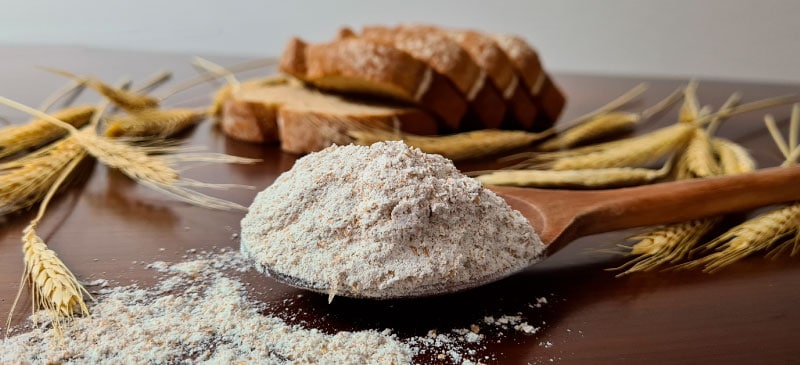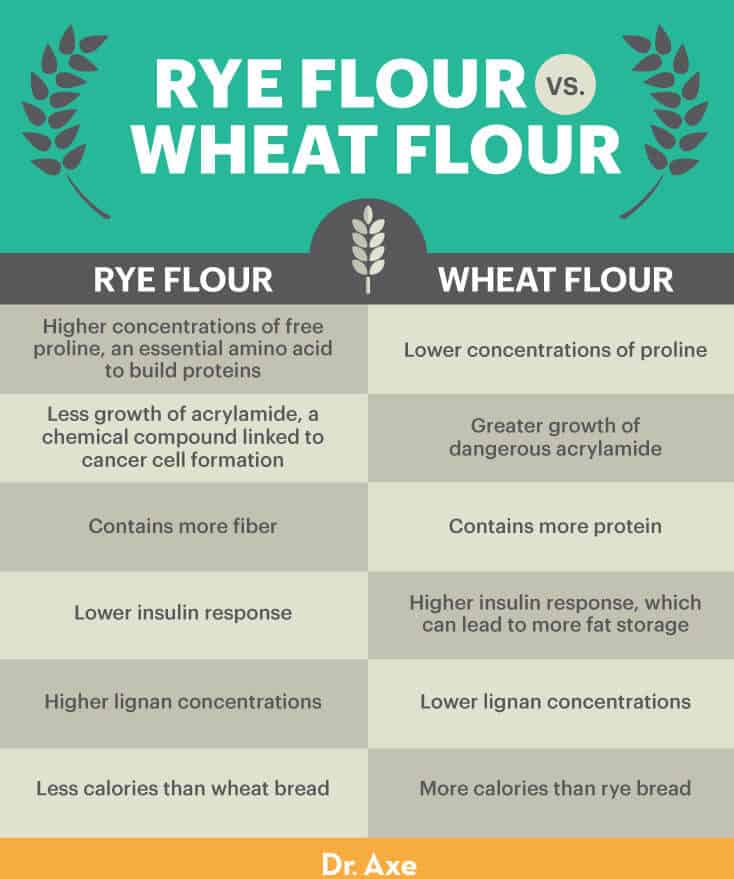
Rye — and rye flour — is a rich, hearty grain that has been consumed for centuries. Although you might find wheat and other cereals more readily available at your market, it’s worth taking a chance on this cereal grain.
Rye bread and rye flour nutrition differs from wheat, barley and oat and often packs more of a punch, especially if you opt for the dark variety, which holds more potent health benefits. The rye seed, or rye berries as they’re called when harvested and sold in full form, are also healthy and useful in cooking.
You might wonder: Is rye bread healthy? It’s actually one of the healthiest breads and grains in the world!
Some of the most impressive health benefits of rye flour are its ability to help fight against diabetes, cardiovascular disease, weight gain, cancer, inflammation and high blood pressure.
What Is Rye Flour?
Is rye a gluten-free flour? It’s not.
Ad

Rye is one of the three gluten grains, along with wheat and barley. It contains a protein called secalin, which is a form of gluten. However, rye flour, when used in baking, contains much less gluten than wheat and barley.
The type of gluten in rye, unlike the gluten in wheat, is much less elastic and also poorer at trapping bubbles during the baking process, so the rye produces a much less airy bread. It also holds more free sugars, which means that rye ferments faster as well.
Rye flour tends to be more nutritious than wheat or barley because of the whole nature it comes in, with endosperm, which is in the outer hull of the rye berry or kernel. The endosperm holds potent starches as well as fiber and nutrients.
It’s much harder to separate and remove the germ and the bran from the endosperm during the milling, therefore carrying with it more vitamins and nutrients into the end product of rye flour.
Health Benefits
1. Helps Lower Weight and Cholesterol
Rye flour can positively affect you metabolically speaking. Rye positively differs from wheat when digested, and it’s been shown to actually suppress body weight gain, as well as significantly lower obesity, in mice.
Whole grain rye has been shown to improve insulin sensitivity and lower total plasma cholesterol.
This makes rye a cholesterol-lowering food and effective weight management flour.
2. Glucose Control
Rye flour and rye bread can also help regulate and improve the blood glucose profile. When scientists from Sweden studied the effects of rye in patients tested during breakfast meals, they found that whole grain rye products, bran rye breads and endosperm rye flours, especially sourdough rye breads, were excellent at improving glycemic profiles, stabilizing insulin responses and improving sensitivity to insulin.
This shows that rye flour can help manage and lower the risk for diabetes.
3. Appetite Control
Not only can rye flour help you to eat less during a meal, but it helps you feel satisfied for hours after you finish your meal. In one study, it was shown that patients who received the same amount of caloric intake from their breakfasts but were given rye porridge instead of wheat or another grain had a satisfied feeling without needing to intake more food for up to eight hours after their meals.
A similar study was conducted but used rye bread instead of rye porridge. Researchers found that having rye bread at at meal led to less appetite before and after the meal, showcasing rye’s powerful ability to help achieve satiety.
4. Inflammation
When patients with metabolic syndrome were put on a 12-week diet of rye and pasta, it was shown that the insulin responses after meals were better and helped reduce inflammation in the body as a result compared to a 12-week diet of oats, wheat bread and potatoes.
This reduction in inflammation in metabolic syndrome patients can be beneficial in reducing the chances of diabetes as well.
5. Gene Regulation
It’s been shown that while everyone has certain genes in the body that make that person more susceptible to various conditions, diet and lifestyle can help train these genes to be “down-regulated.” Studies have shown that by replacing an oat-wheat-potato diet with rye products can actually help down-regulate genes that can lead to diabetes and other serious health issues.
In fact, research has shown that patients on a predominantly oat-wheat-potato diet have actually up-regulated genes associated with negative health outcomes, making rye a much better option.
Ad

6. Gallstones
The insoluble fiber that is so high in rye breads and rye flour products can help reduce the risk of gallstones. The fiber in rye flour helps speed up elimination time in the intestine as well as reduce the amount of bile acids in the stomach that lead to gallstones.
That’s why high-fiber foods like rye are so beneficial to your digestion and waste elimination.
READ RELATED: For Perfectly-Baked Banana Bread That Requires Almost Zero Effort, Use Your Grill—Here’s How
7. Fights Cancer
Whole grain rye flour has many potent cancer-fighting properties. These include high amounts of soluble and insoluble fiber, polyphenols, saponins, phytic acid, resistant starch and protease inhibitors, which help prevent cancer cells from spreading.
In fact, these same phytonutrients that help fight and prevent cancer also have shown the ability decrease the risk of heart disease and reduce the negative symptoms of menopause.

Nutrition Facts
Rye flour is truly loaded with key nutrients, especially phosphorus, magnesium, zinc and iron.
- Calories: 416
- Total Carbohydrates: 88 g
- Total Fat: 2.8 g
- Saturated Fat: 0.3 g
- Polyunsaturated Fat: 1.3 g
- Monounsaturated Fat: 0.4 g
- Trans Fat: 0 g
- Protein: 20.4 g
- Sodium: 2.6 mg
- Phosphorus: 639 mg (64% DV)
- Magnesium: 205 mg (51% DV)
- Zinc: 6.5 mg (43% DV)
- Iron: 6.4 mg (36% DV)
- Vitamin B6: 0.6 mg (28% DV)
- Thiamine: 0.4 mg (27% DV)
- Niacin: 5.5 mg (27% DV)
- Potassium: 918 mg (26% DV)
- Riboflavin: 0.3 mg (19% DV)
- Folate: 76.8 mcg (19% DV)
- Pantothenic Acid: 1.6 mg (19% DV)
- Vitamin E: 3.5 mg (12% DV)
- Vitamin K: 7.6 mcg (9% DV)
*Daily Value: Percentages are based on a diet of 2,000 calories a day.
Rye Flour vs. Wheat Flour
- Rye flour has much higher concentrations of free proline, an essential amino acid to build proteins, than wheat flour. In addition, this concentration also distinguishes itself from wheat because it has shown much less growth of acrylamide, which is a chemical compound that is linked to the formation of cancerous cells within starchy foods like potatoes and wheat products.
- Though wheat bread generally contain more protein, wheat having six grams per two slices versus 5.4 for rye, rye bread has more fiber: 3.7 grams vs. 2.4 per two slices.
- Wheat promotes a higher insulin response in the body compared to rye, so the body tends to store more fat if ingesting wheat more regularly than rye.
- Rye contains more soluble fibers than wheat, sometimes as much as three times the amount as white-wheat breads.
- Rye bran has one of the highest concentrations of lignans compared to wheat and other grains.
- Rye breads contain 20 percent less calories than white wheat bread.
Rye, or Secale cereale, is not as popular as other cereal grains.
This long, slender grain, in the same family as barley and wheat, while having a history dating back to 400 B.C. or earlier, is actually one of the newer cultivated grains. It was first harvested wild, found in Central Asia mainly around Turkey and northern points of Asia and Europe later on, after the Bronze Age.
Rye was first found growing wild among fields of wheat and barley. There have been findings of cultivated fields from ancient Romans, as well as Neolithic periods.
Rye is drought-resistant and can flourish in poor soils, so it was a useful crop in the Middle Ages, especially in Northern and Central Europe.
Rye became the most common cereal grain in Nordic culture during the Iron Age and remains a steady grain in that culture’s diet today. Many Nordic farmhouses cooked rye breads using sourdoughs and malt syrup sweeteners.
Poland, Russia, Germany and many other Central European countries have rich histories in making breads from rye because of the spread of the crop and its ease of growing, as well as the propensity for the breads made with rye flour to last much longer once baked.
Rye was brought to America by Dutch and English travelers after being co-evolved with barley and wheat to what we now know as modern barley.
How to Use and Cook
While there is no standardization for rye flours, there are different versions available. The most healthy version of rye flour is whole grain, dark rye.
Rye flour comes in three varieties:
- Light — takes out most, if not all, of the nutritious kernel
- Medium — contains some of nutritious kernel
- Dark — may contain most or all of the nutrient-rich kernel
Rye flour is mostly sold as medium rye flour. Pumpernickel flour is dark rye flour made from whole grains and is used in bread making.
Dark rye flour tends to be the least refined, coarser ground and holds the most health benefits in flour form. Rye meal is a step above all, which contains all of the germ, bran and endosperm.
Rye berries are the rye seeds harvested from this grass in its unrefined state and can be used as a porridge or cereal and in salads and more. The rye berries can also be ground into rye flour for baking.
Rye flour produces heavy, dense bread. For better rising, you can blend rye flour with a higher-protein flour.
It’s important when buying rye flour in bulk to make sure the bins are airtight and labeled. Store your rye flour in a cool, dark place.
You can bake with rye flour as you would wheat flour. It has a deep, rich taste that can add a lot of depth to your baking. You can also use rye berries as you would barley or other grain “berries,” soaking them to sprout them, or cooking them in liquid and tossing with vegetables, salads and more.
Recipes
Bread or grain breads are popular to make with rye. You can make any assortment of breads from Jewish rye to an intensely rich sourdough pumpernickel. Also make sure to check out Ezekiel bread using organic sprouted rye as the raw whole grain.
You can even make a powerful probiotic drink from rye! Kvass is made from stale rye sourdough bread.
Risks and Side Effects
The amount of gluten in rye flour products is lower than what’s in wheat flour products, but it’s still there.
If you are avoiding gluten, think you might have gluten intolerance symptoms and especially if you suffer from celiac disease symptoms, you should avoid rye in any form as it does contain gluten.
Final Thoughts
- A grain packed with vitamins and nutrients, rye flour is versatile and can often be used to replace other flours when used in baking.
- Rye flour adds a hearty, deeply rich flavor to your taste buds while supplying your body with major health benefits.
- It can help prevent and fight a wide array of health afflictions, from high blood pressure and obesity to diabetes and cancer.
- It even contains less gluten than wheat to boot.
!function(f,b,e,v,n,t,s)
{if(f.fbq)return;n=f.fbq=function(){n.callMethod?
n.callMethod.apply(n,arguments):n.queue.push(arguments)};
if(!f._fbq)f._fbq=n;n.push=n;n.loaded=!0;n.version=’2.0′;
n.queue=[];t=b.createElement(e);t.async=!0;
t.src=v;s=b.getElementsByTagName(e)[0];
s.parentNode.insertBefore(t,s)}(window, document,’script’,
‘
fbq(‘init’, ‘3475171552810057’);
fbq(‘track’, ‘PageView’);





